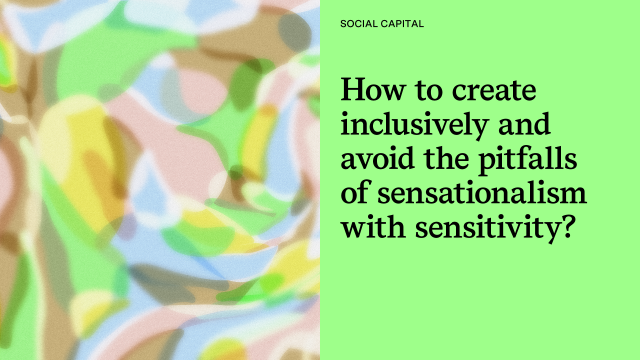
How to create inclusively and avoid the pitfalls of sensationalism with sensitivity?

Tools, measurement frameworks and work methodologies—new ones appear year after year. So it’s only natural, and even desirable, to question their credibility and all the considerations underlying them. This is why we felt it was essential to explain why the methodology behind our Social Capital Index is relevant and how it came to be.
This is the obvious first question! There are already many existing work methodologies that evaluate companies’ social and environmental responsibility, the impact they generate, the traceability of their supply chains, the environmental impact of their products and services, etc. But there was no tool to evaluate whether a company was correctly communicating its impact initiatives or if it was involved in greenwashing. How could we know whether a company was communicating too much or too little about its responsibility as a business?
Plus we had other questions. How could we measure the social capital we generate through our work with our clients? Are we really helping companies create impact and improve their communications? To answer these questions, we needed to equip ourselves with a measurement framework that could assign some numbers to the creation of social capital so we could then measure its improvement over time.
It seemed obvious to us that a survey would be the best way to collect the information we needed to evaluate the balance between a company's impact initiatives and its communications about them. Our survey, which includes 99 questions, is divided into two sections. The first half of the survey contains questions about impact, while the second half deals with the company’s communication practices.
In the impact section, we distinguish between activities that mitigate a company’s negative impact and those generating positive impact on its value chain. This distinction lets us adjust the weighting as a result. Obviously, each question has been weighted based on the potential impact it may generate. For example, setting up composting (a mitigation of a negative impact) at a company’s offices won’t generate the same societal impact as creating a social re-entry program for former prisoners (a creation of positive impact). In the impact section, you will also find questions that identify social, environmental and governance initiatives that have already been established by companies. Naturally we don’t merely want to learn about the initiatives themselves, but also validate the presence of targets, performance indicators and formal commitments related to each initiative.
Our impact questions cover both the company’s business model as well as its environmental, social and governance impact, including work conditions and diversity and inclusion. A company’s business model is often what allows it to generate impact by default and, above all, by intention. For us, an impact business model is therefore directly related to the creation of positive impact.
In the second part of the questionnaire on communication practices, we survey companies about the social and environmental issues they took a position on. The frequency with which these issues were addressed and their investment in communicating their impact as well as in local media are also covered in this section.
Throughout the survey, weighting was necessary to ensure the scoring represented the actual impact of a company. We also prioritized closed-ended questions to ensure objectivity and precise measurement.
Over a hundred hours were invested in thinking about which answers and which activities really deserved more points and why. It should be noted that many minds debated, deliberated and put their objectivity on display to reach as much of a consensus as possible on what best represented Republik’s vision.
After an organization has completed the survey, it receives an email with its impact score and its communication score. An overall grade is also determined based on these two scores. The overall grade is not the average of the impact and communications scores. Our impact and communication specialists have determined the rules in order to maintain a balance between impact activities and the intensity of impact communications.
Our main rules are as follows:
Our many rules allow us to always change the overall grade while maintaining the guiding principles we have prioritized. We have readjusted our ratings numerous times so that all of our tests are conclusive and aligned with our methodology.
We created two versions of our survey: a complete version for our clients as well as a shorter version that is available online in order to make this tool accessible to all companies and democratize the measurement of impact communications. The overall grade for the shorter version may therefore differ from the overall grade obtained by clients, but it still provides a very good idea of the maturity of a company’s impact.
To take advantage of comprehensive support from our specialists, please get in touch with us so that we can take you through the long version of our survey.
As mentioned in the social capital index FAQ, the current version is actually a Beta version. Our team wanted to take the time to test this first version and refine it based on the feedback it will receive. We have already identified possibilities for improvement so that the results of the survey better reflect the reality of each business sector. We also need to consider other elements of communication that we would like to include in our evaluation, but which have not yet been taken into consideration in this first version of the index.
Our intention is for our specialists to measure our clients’ overall score every two years in order to see the improvement in their scores as well as ensure we are creating more social capital. We now begin all new mandates with the administration of this social capital index.
These results will be shared in our upcoming impact reports to track the progress of our portfolio of clients.